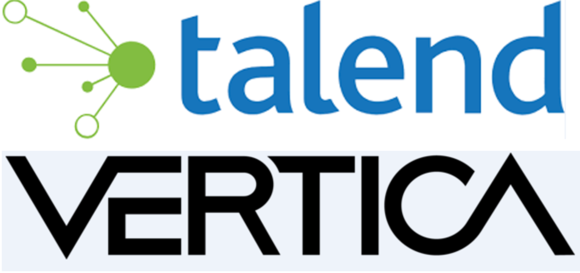Configuring Talend for Use with Vertica
To configure Talend for use with Vertica, you must understand:
Using Talend Components for Vertica
Talend provides a number of Vertica-specific components that you can use to manage your ETL jobs. Understanding the ETL flow and loading guidelines can help you determine which components to use, and how best to use them.Understanding ETL Flow and Loading Guidelines
Understanding the basic ETL flows helps you decide which Vertica component and options to use. This section addresses the following load types:| Type of Load | Use this COPY Option | Results |
|---|---|---|
| Small Bulk Load COPY (<100mb font=""> | AUTO |
|
| Large Bulk Load COPY | DIRECT |
|
| Incremental Load COPY | TRICKLE |
|
- Use COPY to load large amounts of data. Using COPY avoids fragmenting the WOS and doesn't require the overhead that using INSERT does.
- If your row count is small (fewer than 1000 rows), use INSERT.
- Load multiple streams on different nodes.
=> INSERT /+*direct*/ INTO table SELECT…Commonly Used Vertica Specific Talend Components
The following Talend 6.4.1 components are specifically for use with Vertica:| Component | Description |
|---|---|
| tVerticaInput | Extracts data from Vertica. |
| tVerticaBulkExec | Loads from a file. |
| tVerticaOutputBulk | Writes to a file. |
| tVerticaOutputBulkExec | Writes to a file and loads the data. |
| tVerticaOutput | Inserts or updates rows into a Vertica table. |
| tVerticaRow | Executes the SQL query stated against the Vertica database. |
tVerticaInput
The tVerticaInput component allows you extract data from Vertica. Give special attention to the DATE and VARCHAR fields, as follows:- DATE fields—All DATE fields must be in MM-DD-YYYY format. Check your DATE fields and correct the format wherever necessary, as shown in the following dialog box.

- VARCHAR fields—Talend examines a sampling of the data when determining the size of the VARCHAR field. If the table contains large VARCHAR values, consider increasing the default column size.
Note
You can also use the tMap component to transform or remap the data type.
tVerticaOutput
tVerticaOutput provides options that you can change, depending on the size and type of load. Specifically, you should change the Action on Data and Action on Table options, as described in the following sections.Basic Settings for Trickle or Incremental Loads (Writing to WOS)
Set the Action on Table and Action on Data options according to your use case. For trickle or incremental loads, set Action on Data to INSERT.
Advanced Settings for Trickle or Incremental Loads (Writing to WOS)
When writing to the WOS, use the default values for Advanced Settings as follows.
To enable fields for INSERT, UPDATE, and DELETE, select the Use field options checkbox. The default settings in the previous graphic generate the following SQL statements:
2018-05-15 05:24:36.797 Init Session:7f17b3fff700 [Session] [PQuery]
TX:0(v_target_l1_node0001-40400:0x1091f) INSERT INTO public.VarChar4k_Table
(DataTypeSet,ValueDesc,VarChar4k_Column) VALUES (?,?,?)Note
These default settings do not generate a COPY statement.
Basic Settings for Large, Bulk Loads (Writing to ROS)
For large, bulk loads, use the DIRECT syntax to write to ROS. To do so, you must set the Action on data option to COPY.
Advanced Settings for Large, Bulk Loads (Writing to ROS)
When using COPY, use Advanced Settings to specify filenames and locations for exception files.
The settings in the preceding graphic generate the following SQL statements:
2018-05-15 05:19:44.584 Init Session:7f17fd7ca700-a0000000044bf8 [Txn]
Rollback Txn: a0000000044bf8 'COPY public.VarChar4k_Table
(DataTypeSet,ValueDesc,VarChar4k_Column) FROM local STDIN UNCOMPRESSED WITH DELIMITER ';'
RECORD TERMINATOR '' ENCLOSED BY '|' NULL AS '' EXCEPTIONS 'C:/data/except_file.txt'
REJECTED DATA 'C:/data/except_records.txt' DIRECT NO COMMIT'
tVerticaOutputBulkExec
The tVerticaOutputBulkExec component writes to a file and then copies the data using standard input (STDIN).Basic Settings

Advanced Settings
By default, tVerticaOutputBulkExec writes to the ROS.
The settings in the preceding graphic result in the following SQL statements:
2018-05-15 05:20:44.526 Init Session: 7f17b37fe700-a0000000044c10
[Txn]
Starting Commit: Txn: a0000000044c2d 'COPY
datatype_ss.VarChar_Table FROM local STDIN DELIMITER ';' NULL 'null'
DIRECT returnrejected'tVerticaRow
The tVerticaRow component allows you to specify any valid Vertica SQL statements, including COPY statements. Use tVerticaRow to load data into Vertica flex tables, or for other scenarios that require Vertica structures that are not supported with custom Talend components.Example: High-Performance COPY
In the following example, the source file is on the Vertica server and uses the high-performance Vertica COPY (not COPY FROM LOCAL). Whenever the source files are on the Vertica cluster, load data using high-performance COPY."COPY talend.store_target FROM '/home/dbadmin/store.csv' DELIMITER ';'
NULL '' DIRECT;"Example: Loading into Flex Tables
This example shows how to run the Vertica flex example included in the Vertica package directory.To create the flex table:
=> CREATE FLEX TABLE mountains();=> COPY mountains FROM
'/opt/vertica/packages/flextable/examples/mountains.json'
PARSER FJSONPARSER();=> SELECT COMPUTE_FLEXTABLE_KEYS_AND_BUILD_VIEW('mountains');Example: Performing Vertica-to-Vertica COPY
This example shows a Vertica-to-Vertica COPY:“CONNECT TO VERTICA vmart USER dbadmin PASSWORD '' ON
'VertTest01',5433;COPY customer_dimension FROM VERTICA
vmart.customer_dimension DIRECT;”Connecting to a public network requires some configuration. For information about using this statement to copy data across a public network, see Using Public and Private IP Networks in the Vertica documentation.
Using Generic Talend ELT Components with Vertica
The ELT family of components group together database connectors and processing components for ELT mode, where the target DBMS becomes the transformation engine. When possible, SQL statements are combined and processed in a single query on the database. The following illustration shows how Talend supports ELT with Vertica. This example uses the generic components for the entire job.
When this job runs, Talend generates the following SQL statements:
=> INSERT INTO store.regional_sales (store_name,store_city,store_region,sales_quantity,
sales_dollar_amount)
(SELECT Store.store_dimension.store_name , Store.store_dimension.store_city ,
Store.store_dimension.store_region , sum(store.store_sales_fact.sales_quantity),
sum(store.store_sales_fact.sales_dollar_amount) FROM Store.store_dimension INNER JOIN
store.store_sales_fact ON
( store.store_sales_fact.store_key = Store.store_dimension.store_key )
group by Store.store_dimension.store_name,
Store.store_dimension.store_city,Store.store_dimension.store_region )Other Components for Bulk Loading
The tVerticaOutputBulk and tVerticaBulkExec components are generally used together in a two-step process. First, an output file is generated. In the second step, the output file is used in the INSERT operation that loads data into a database.You can also choose to do both steps at once using the tVerticaOutputBulkExec component. However, using tVerticaOutputBulk and tVerticaBulkExec allows the data to be transformed before it is loaded in the database.
Using the Talend SQL Builder
When using the SQL builder, be sure to include the schema name in the query:=> SELECT * FROM store.store_dimension;Enabling Parallelization in Talend
You can enable parallelized data flows. To do so, partition an input data flow of a Talend subjob into parallel processes and execute these processes simultaneously.Enabling Parallelization in the Talend Enterprise Edition
If you are using the Talend Enterprise Edition, you can enable or disable the parallelization with a single click. Talend Studio then automates the implementation across a given job. For more information about this feature, click the following link:Enabling Parallelization in the Talend Community Edition
If you are using the Talend Community Edition, add a WHERE clause to the original query to chunk the data. This example results in four chunks.original_sql + " and hash(" + primaryKey + ") % " + noOfThreads + " = " + i=> SELECT if.* FROM inventory_fact if, warehouse_dimension wd WHERE
if.warehouse_key=wd.warehouse_key=> SELECT if.* FROM inventory_fact if, warehouse_dimension wd WHERE
if.warehouse_key=wd.warehouse_key AND HASH(product_key, date_key) % 4=1;
=> SELECT if.* FROM inventory_fact if, warehouse_dimension wd WHERE
if.warehouse_key=wd.warehouse_key AND HASH(product_key, date_key) % 4=2;
=> SELECT if.* FROM inventory_fact if, warehouse_dimension wd WHERE
if.warehouse_key=wd.warehouse_key AND HASH(product_key, date_key) % 4=3;
=> SELECT if.* FROM inventory_fact if, warehouse_dimension wd WHERE
if.warehouse_key=wd.warehouse_key AND HASH(product_key, date_key) % 4=4;Key : 235164 Value : product_key , Key : 50148 Value : date_key
count, chunk
7501441, 1
7500008, 2
7497028, 0
7501523, 3


